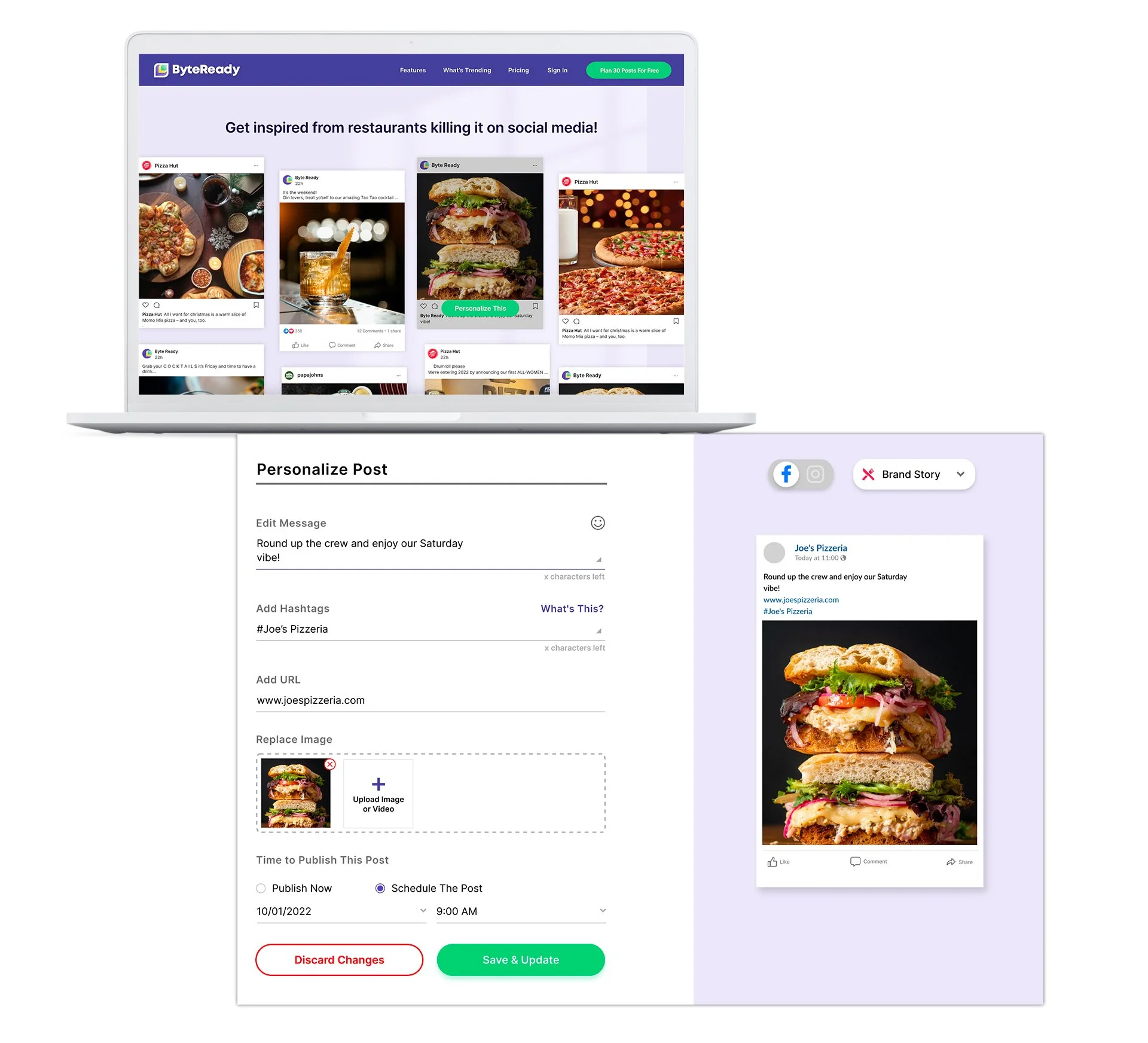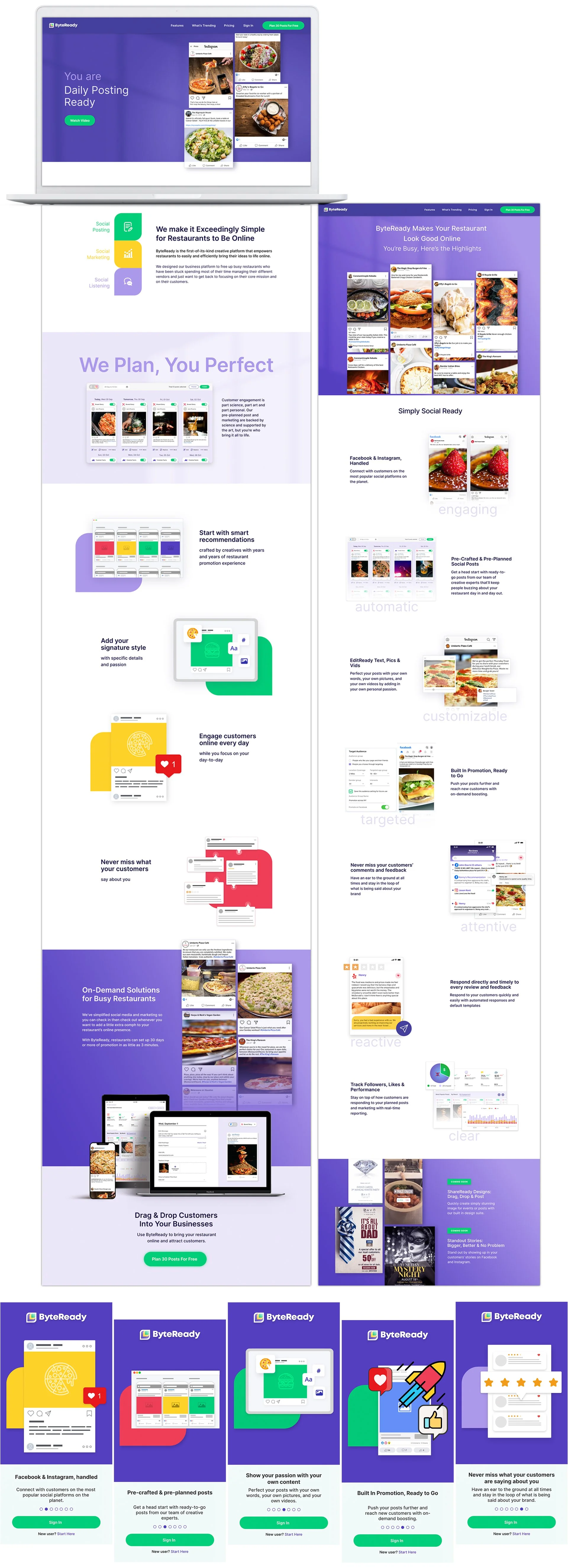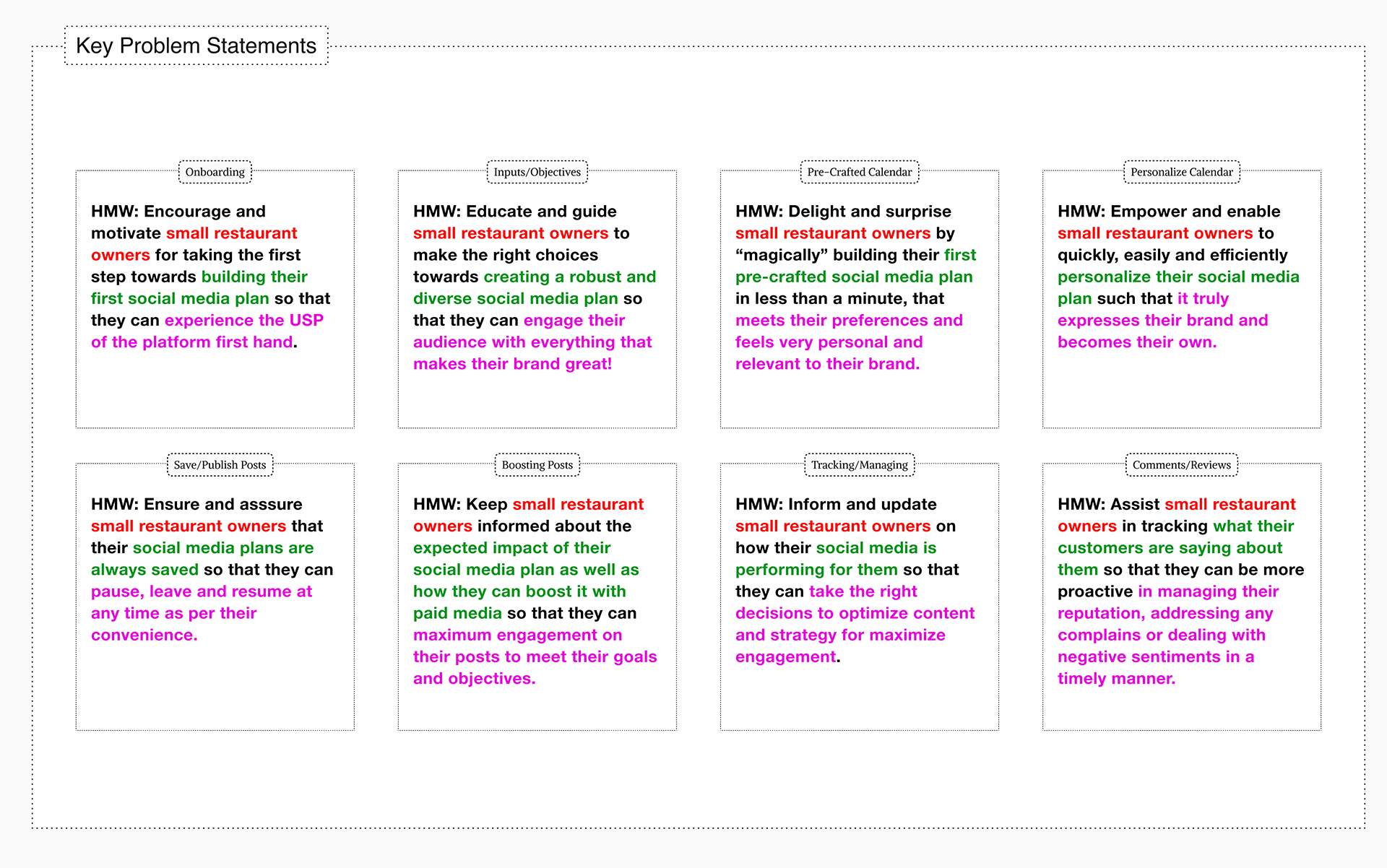A SaaS platform to provide small restaurants a social media and marketing lifeline
Client: Byte Ready
Duration: 6 months
Team: Niven (UI), Anubhav (UI), Dinesh (UI), Andrew (Copy), Mili (Brand)
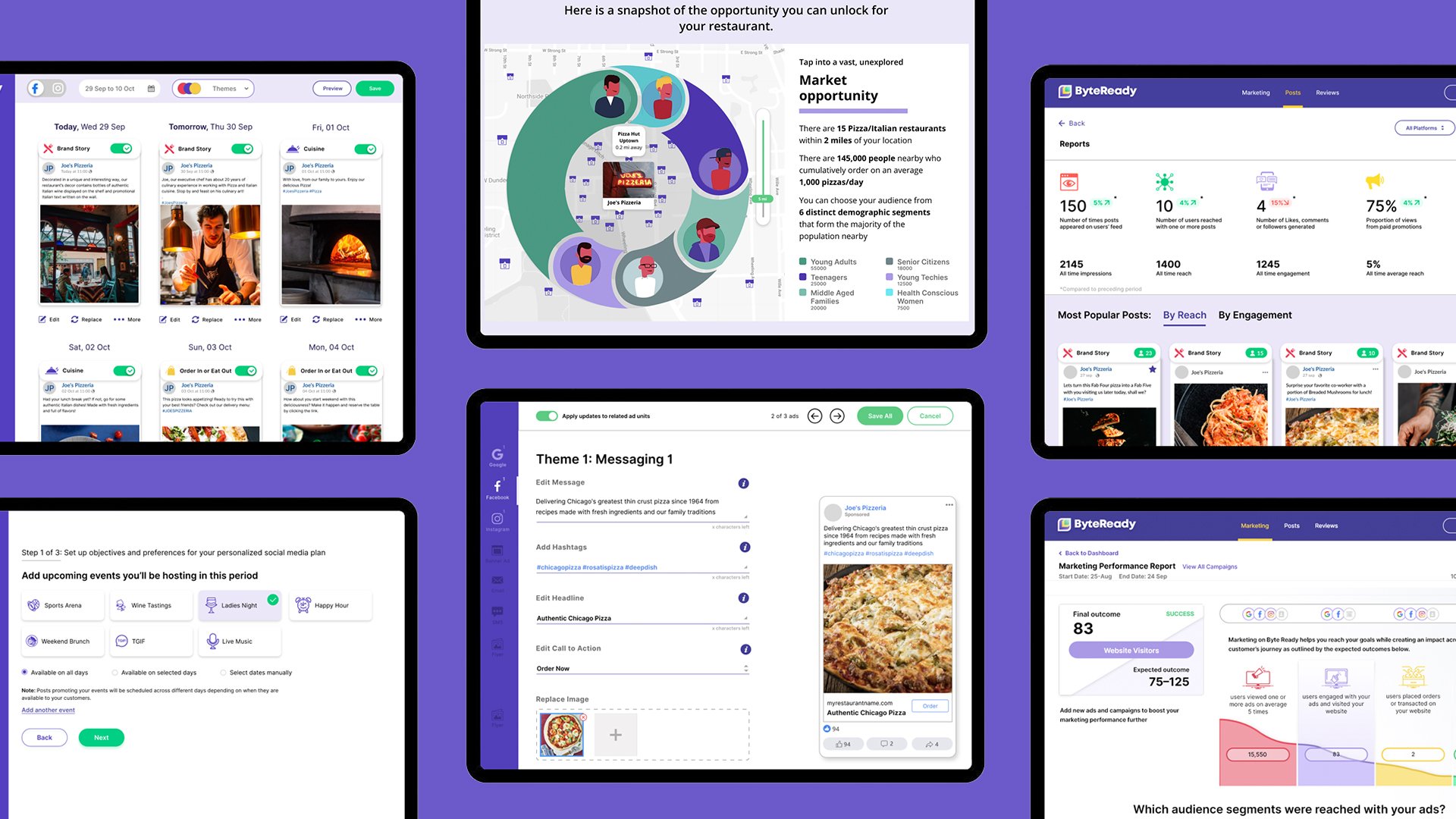
I led the design for the platform along with one UX designer and two visual designers. Throughout the design process, I worked very closely with the founder of the company who provided the high level strategy and also collaborated with a Researcher, Content Strategist and Ad Designer.
Currently (December 2021), I am coordinating with the Technical team to review their production builds as well as collaborating with the team to design the next phase of the offering. The beta is expected to launch for the US market in March‘22.
The Challenge
All of us have come across restaurants, cafés and bars that just seem to struggle even if they are one of a kind and have something going for them. It’s clearly not enough for them to simply provide better food and service, they have to do a better job of promoting their brand, compete with bigger chains to acquire their audience and convert them to loyal customers.
However, some of the biggest challenges in running a successful restaurant today relate to online marketing and social media where customers spend the bulk of their time today. A small restaurant owner has his hands full simply running day-to-day operations and the prospect of staying updated on what all is happening online and cutting through the noise on what solutions are available proves very overwhelming to even the most enterprising owners!
Background & Objective
Since 2016, the team behind Byte Ready has been a reliable digital partner for over 500 small restaurants. With their blended approach of strategic leadership, high quality content and understanding of data, their integrated multi-channel approach has generated the highest ROI of all digital channels with over 80% restaurants breaking even and 25% turning profitable within 3 months of running their program *.
With a vision to scale their offering to thousands of businesses globally with less effort than their traditional approach of providing personalized services, they came up with the idea to “productize” their offering and create a one-of-its-kind platform using creative best practices, process automation and cutting edge technology.
* Based on actual performance data of over 100 restaurants
“Let's be the all-encompassing digital platform restaurants truly need to succeed online”
— The rallying cry from the founder
Dream It
Create awareness about the scope and size of market opportunity
Build It
Make it enjoyable to build a strategic plan and publish content online
Manage It
Maintain their social media presence and online reputation across the web
Track It
Provide complete transparency over the wholesome impact of marketing
Initial Insights
The founding team has extensive experience of working closely with hundreds of restaurants across some key markets like New York, Chicago and San Francisco. I kicked off the research process by having discussions with the front-end team to understand the challenges they faced and the opportunities they saw through their interactions with the owners and key staff. I also participated in some meetings and interviews with half a dozen of their key clients across different types and sizes.
As an outcome of this discovery process, there were five core friction points identified for this platform to solve:
Owners do not realize the scope of opportunity
Most restaurant owners are neither aware of the scope of the market nor how to use the digital ecosystem to grow their business. Even those brands that consider themselves successful actually had a very small business relative to the size of the opportunity.
They avoid complex, time-intensive experiences
Most restaurant owners are too busy to spend time learning new platforms, preplan their social media calendar or build out a sophisticated marketing plan spanning different channels.
They find producing quality content and creative extremely overwhelming
They believe posting content online is a fun way to build engagement with their audience but struggle to carve out time to produce unique and diverse content that their customers can engage with and share.
They’ve never understood return on marketing investment
Restaurant owners are not savvy marketers and do not extract much value in ogling at detailed charts or graphs marketing platforms typically offer. They haven’t seen or been able to realize any significant impact online activity has had on their business.
They will test the waters before making a commitment
Many owners tread cautiously while investing in new solutions because in their past experiences with other vendors, the quality of work was found to be neither inspiring nor impactful to their business. Until they see a clear value in quality, efficiency and impact, they won’t commit to a long term relationship.
Defining the problem
Small and independent restaurant owners try to manage their online presence, either on their own or with multiple vendors, often at the cost of taking their focus away from serving their customers, yet failing to create any valuable impact consistently.
Key use cases
I need to post compelling content everyday
I need more exposure and engagement on my content
I need to grow my sales and customer base over time
I need to reach my loyal customers with new promotions and specials

Executive Summary
Byte Ready is the only creative-technology platform that allows restaurant owners to pick and use the online services they need, so they can generate long term sustainable revenues with maximum efficiency at minimal cost.
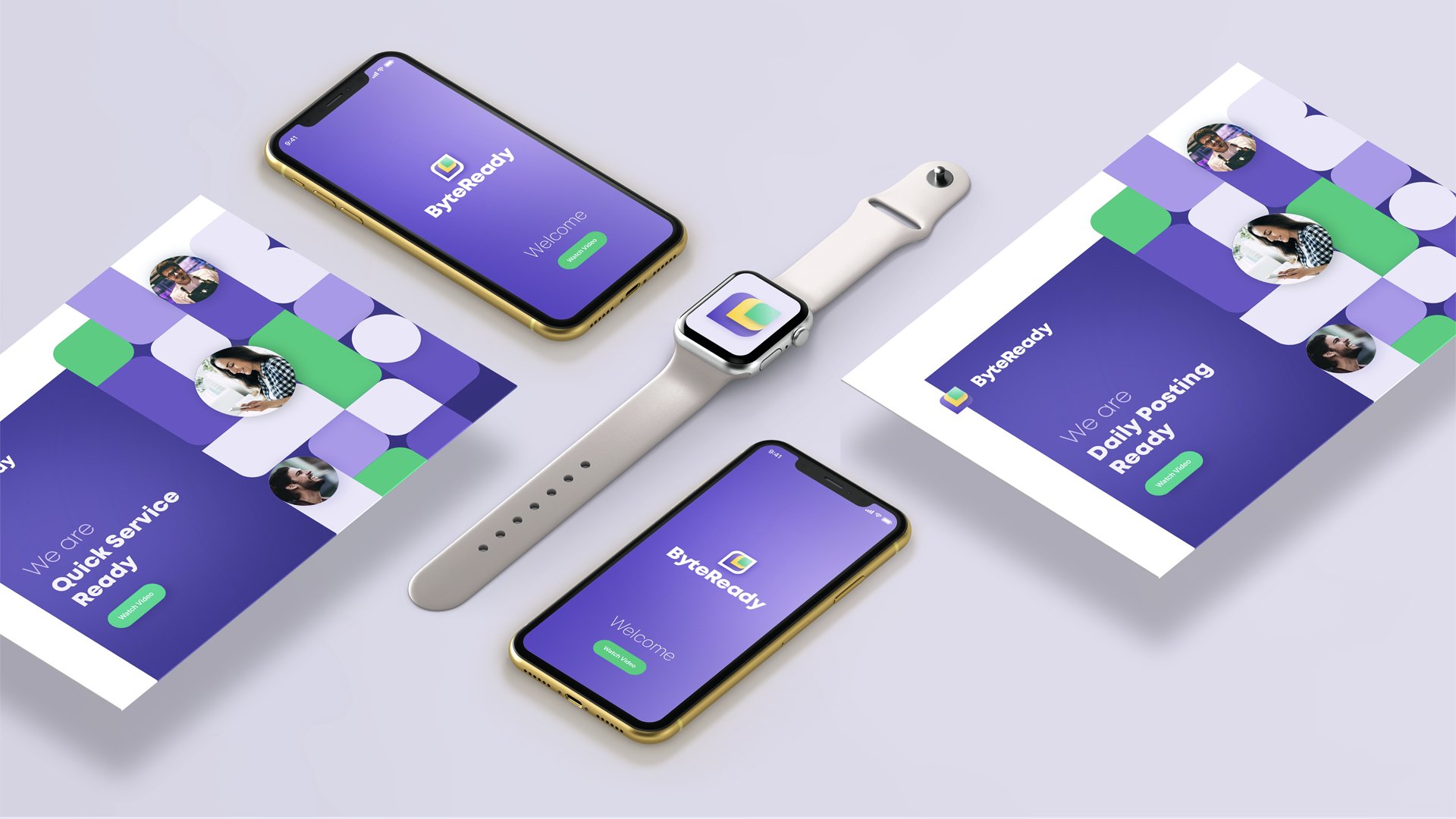
Brand Design Principles
These brand design principles became the foundation of my work with the rest of the team and below I share some of the salient aspects of what’s driving us forward.
Nothing is more expensive than a missed opportunity
Narrative: Small restaurant owners are often not aware of the scope of the market around them and even those that consider themselves successful have a very small business relative to the size of the opportunity. The first thing we wanted to do was to make restaurant owners aware of the size and demographics of the market available to them. The challenge was not just the data but more importantly how to package and present this in a manner that is easy to comprehend, lights a bulb and compels the businesses to take action!
Solution: We decided to create a “no-signup” onboarding experience that pulled new users in by simply asking them to enter their restaurant name in return for quick insight into the market opportunity around them. Using data from 3rd party APIs, we designed a custom map that allows owners to view the overall size of the market, number of competing restaurants and key audience demographics residing within their coverage area. Next, we gave them a peek into how they can engage their preferred audience segments using targeted content across various channels.
Different goals demand different approaches and solutions
Narrative: Each restaurant can have a different marketing goal. A newly launched unit may benefit by having more and more people being aware of their brand. Other restaurants may be looking to grow an active fan base through social media platforms. And some may be looking to grow their online orders or events bookings through regular emails to existing customers. For this reason, a one-size-fits-all approach will not be able to drive the maximum result required.
Solution: For each objective, we designed a uniquely tailored experience that walks restaurant owners through a step-by-step approach to get there. They typically do not understand marketing terminology and despise having to deal with complex workflows, so each workflow was broken down into a series of simple steps, allowing users to see their progress and pause, save or resume at any given point of time.
Content is the atom of every social media and marketing plan
Narrative: Content remains the single most critical element of any online communication strategy. Posting on social media is a great way to build engagement provided it is done consistently and content is diverse. However due to low penetration of organic social media, restaurants need to go beyond and look to adapt their messaging for various paid channels. Even with their regular loyal customers, a proactive and personalized communication plan is a must to keep them engaged with new promotions and offers. All of this work puts a lot of pressure on small restaurant owners to produce high-quality and unique content on-goingly.
Solution: Having managed thousands of campaigns for restaurants, the team behind Byte Ready was as well positioned as anyone else in the industry to build the first-of-its-kind content ecosystem by leveraging best creative practices, templates and formats. For social media calendars, a database of 100,000 posts were tagged for cuisine, buckets and types so that the platform could generate a personalized calendar automatically based on restaurant’s cuisine, location and preferences. Finally, robust personalization tools allow users to completely replace a post with an alternative, swap between two posts or simply edit a caption and image.
“Everyone” is NOT your customer, so find your niche!
Narrative: When it comes to marketing online, targeting a broad group of people might sound logical, but the more people brands try to appeal to, the more money they end up spending and the more diluted the value proposition becomes. Anyone and their uncle can turn on Facebook ads, but defining and building the right target audience that will want what the restaurant’s offering requires both gut instinct as well as testing.
Solution: Whether they are looking to reach and acquire new audiences or engage existing ones to return, we designed interactive tools to let them define what kind of users should be targeted with the marketing campaign. Only when they know what their target customers look like, they can hope to build sustainable engagement and ROI for the marketing dollars spent on the platform.
Give your content a “boost”
Narrative: The average number of people who see posts on social media that aren’t backed by ad dollars has been declining with all platforms now pretty much operating on “Pay-to-Play” model for brands. Facebook allows brands to view expected reach and increase exposure by boosting posts, but only one at a time.
Solution: We made it easy for users to boost one or more upcoming posts right after scheduling or at any time till (or even after) they are published. Whether they are looking to reach new audiences or engage existing ones to return, the tool gave them easy ways to target broad or precise audiences.
Let’s strive to be authentic, accountable and transparent
Narrative: Restaurant owners are not savvy marketers and do not extract much value in ogling at charts and graphs from marketing platforms who have erected walled gardens around them making data flow between each other awkward and inconsistent.
Solution: We opted for simple messaging and info-graphics in place of charts to make it easy to understand the wholesome impact marketing or social media is having on their key objectives, whether they are on track as measured through KPIs and get smart recommendations for altering tactics to get back on track if they are falling behind.
Knowing what customers are saying is more helpful than worrying about competitors
Narrative: For any restaurant, its online reputation is critical to maintain! They have to have an ear on the ground at all times and constantly look out for any incoming comment. As soon as they spot one, they must take time to respond to each new review, whether it’s a complaint or a compliment. Knowing all they have to squeeze in each day, a lot of issues fall through the cracks often.
Solution: We designed a virtual “Inbox” that automatically consolidates all complaints, compliments and feedback in one place and helps restaurant owners craft suitable responses using a series of pre-populated recommendations based on the tone of the message.
New ideas emerge from inspiration, not just information
Narrative: Finally, after a social media calendar is published or marketing campaign is launched, restaurant owners often get too busy to come back to track, update or optimize their plans. That’s a big opportunity missed not only for the restaurant owners, but also for the platform to benefit from on-going engagement.
Solution: During discovery, we found out that while owners hate to take out time to deal with specifics, they are always excited to see high quality work. And so the idea for a curated collection of trending social media and marketing content from across the world of food and dining, all in one spot, was created. Restaurant owners can always come back to check what’s new. And if they’re truly inspired, they can make and publish new content of their own instead of starting from scratch.
The mobile app for the first phase was designed to let restaurant owners keep a track on their social media performance, boosting or making quick edits to upcoming posts and being able to respond to any reviews, comments and feedback from customers.

Quick snapshot of recent social media performance along with preview of upcoming posts

Making quick edits to one of the upcoming posts before it is published

Virtual "Inbox" capturing all reviews, comments and feedback across the social web

Detailed view of Yelp rating and review received by a restaurant

Responding to review or feedback with the help of pre-crafted responses

Detailed reporting of social media performance including best performing posts
Finally, after handing off the functional modules to developers, I started working on the content and design for marketing pages like the Home page and Features page. This time, I collaborated with a very talented Art Director who utilized bold typography, bright color palette, custom iconography and platform screenshots to breathe life in to the product’s value proposition.
Approach
Three primary factors informed my design strategy
How do you design for a busy restaurant owner who knows social media and online are important but doesn’t want to deal with details?
How do you instill authenticity and transparency so they can understand what value they are creating for their business?
How do you keep them engaged so they are compelled to come back in spite of their busy schedule?
First off, we started to compile everything we know about our audience by building an empathy map while our researcher kicked off the discovery process with an an in-depth exploration of the top five marketing platforms identified as direct or indirect competitors by key stakeholders.
I conducted a remote workshop where members from the strategy, marketing and design teams brainstormed to generate and categorize an initial set of ideas as solvable problems using the popular ‘HMW (How Might We)’ technique
We consolidated all ideas across a category into a consolidated problem statement that explicitly stated what is the problem we are solving in that category and why it is important to solve that problem for the user. A clearly articulated statement helped create a common understanding of the problems to be solved in the design exercise.
Defining primary and secondary user segments helped us to set the right priorities for functions and features in the first phase of the platform
Primary user persona
Category: Small restaurant owners
Demographics: 40–65+, Male/Female
Revenue: $1M–3M annually
Goals & Frustrations:
Tried to do it all on their own, or through multiple vendors, didn’t succeed, decided it’s impossible
Owner acts as manager sometimes chef. Very busy with no time to listen to pitches.
Doesn’t understand marketing terminology
Knows they need to go online but not the extent of it
Recognizes social media content as important but doesn’t want to deal with details and specifics
Will argue that their waiters/family/friends can do social media for them
Would love to know more about their customers but won’t commit to implementation of the program
Gets excited when they see quality work
Want to be rewarded for all their hard work
Secondary user personas
While the team was clear about who they wanted to target with the first phase: the small, independent restaurant owners in the US, I was asked to design the platform to be flexible to be introduced to more user groups incrementally over the next twelve months. The goal was to create design solutions that can extend to any combination of these user personas from the outset.
Global markets and languages (Primarily Middle East and Europe)
Freelancers and independent marketers that work with restaurants
Restaurant managers in regional or corporate chains with multiple units
Simultaneously, as we were brainstorming the different ways users will interact with the platform, I started mapping all the possible interactions into a customer journey diagram.
A mind mapping session for the platform strategy conducted remotely with key stakeholders. The goal of this exercise was to help align user goals with business goals, and clarify the scope of the project. I facilitated the discussions amongst stakeholders and continued to evolve it as we agreed upon a common shared goal.
I iterated my way into final wireframes to test and handover to the visual designers. I prefer adding details into hi-fidelity wireframes as they give stakeholders a pretty good idea of how the platform will function and feel, requiring less imagination. Also, they become the basis from which visual designers and developers can understand the product vision and create real deliverables.
We also decided to put in place Google’s HEART framework to define user experience goals, map them to strategic business objectives and measure how design decisions affect our users perception of the product.
Interactive prototypes turned out to be the most effective way to gain meaningful feedback from the team, consensus from stakeholders and approval from the founder. In fact, I also recorded my prototype presentations as videos with my voiceover, so it can be referred to by the development team anytime during the production cycle.
Testing our designs
Once we had approved prototypes ready for use, I decided to put it out there for some testing with a few restaurant owners who were working with the Byte Ready team already. We conducted remote user testing and uncovered some key insights.
Insight #1: Certain users building their social media posts for the first time were unsure about their overall progress and time it will take for them to publish their first calendar
We replaced the horizontal progress bar on the top of the objectives sequence with a vertical tree view that shows the entire navigation landscape from objectives all the way till the posts are scheduled and boosted.
Insight #2: A user who chose to build a month’s calendar wanted to spend more time in reviewing and personalizing each post but feared he will lose all the work if he stopped and quit now.
Solution: For new users, we left an option to ‘Save’ their calendars which basically was a pseudonym for a signup process, allowing them to the save their progress, pause and resume anytime. For regular users, we added a clear message informing them that their calendars are auto-saved automatically.
Insight #3: We designed and tested a couple of workflows all geared towards getting users to build a comprehensive marketing plan involving all stages of a customer journey, but realized that users neither understand this nor want to invest the time and money needed for it to bear results.
Solution: We compressed the selection of objectives to one screen, explained each option comprehensively in simple language and finally allowed users to start with a specific short term objective requiring small budget and duration.
Insight #4: When we pivoted from a well rounded comprehensive marketing plan to a range of short term objectives, we were forced to redesign the Budget screen as it showed impact across the entire customer funnel that a full marketing plan must impact.












